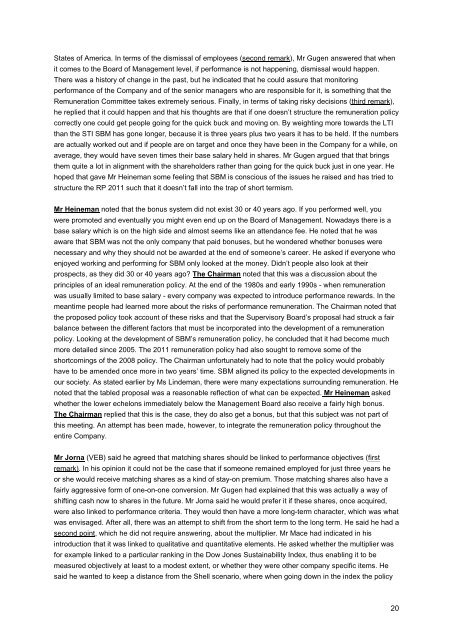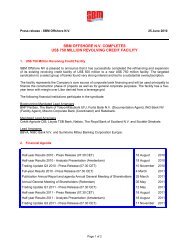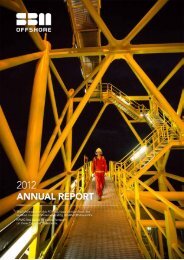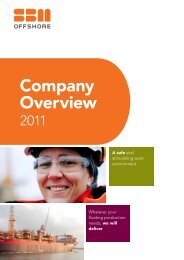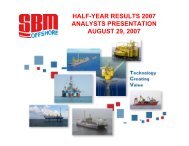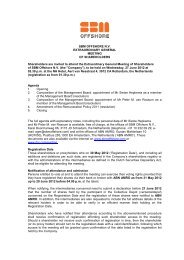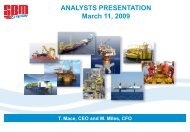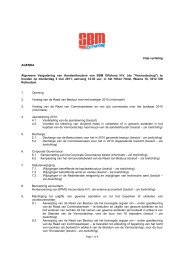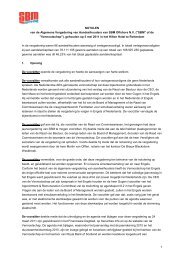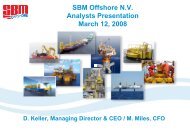1 DRAFT MINUTES of the Annual General Meeting ... - SBM Offshore
1 DRAFT MINUTES of the Annual General Meeting ... - SBM Offshore
1 DRAFT MINUTES of the Annual General Meeting ... - SBM Offshore
You also want an ePaper? Increase the reach of your titles
YUMPU automatically turns print PDFs into web optimized ePapers that Google loves.
States <strong>of</strong> America. In terms <strong>of</strong> <strong>the</strong> dismissal <strong>of</strong> employees (second remark), Mr Gugen answered that when<br />
it comes to <strong>the</strong> Board <strong>of</strong> Management level, if performance is not happening, dismissal would happen.<br />
There was a history <strong>of</strong> change in <strong>the</strong> past, but he indicated that he could assure that monitoring<br />
performance <strong>of</strong> <strong>the</strong> Company and <strong>of</strong> <strong>the</strong> senior managers who are responsible for it, is something that <strong>the</strong><br />
Remuneration Committee takes extremely serious. Finally, in terms <strong>of</strong> taking risky decisions (third remark),<br />
he replied that it could happen and that his thoughts are that if one doesn’t structure <strong>the</strong> remuneration policy<br />
correctly one could get people going for <strong>the</strong> quick buck and moving on. By weighting more towards <strong>the</strong> LTI<br />
than <strong>the</strong> STI <strong>SBM</strong> has gone longer, because it is three years plus two years it has to be held. If <strong>the</strong> numbers<br />
are actually worked out and if people are on target and once <strong>the</strong>y have been in <strong>the</strong> Company for a while, on<br />
average, <strong>the</strong>y would have seven times <strong>the</strong>ir base salary held in shares. Mr Gugen argued that that brings<br />
<strong>the</strong>m quite a lot in alignment with <strong>the</strong> shareholders ra<strong>the</strong>r than going for <strong>the</strong> quick buck just in one year. He<br />
hoped that gave Mr Heineman some feeling that <strong>SBM</strong> is conscious <strong>of</strong> <strong>the</strong> issues he raised and has tried to<br />
structure <strong>the</strong> RP 2011 such that it doesn’t fall into <strong>the</strong> trap <strong>of</strong> short termism.<br />
Mr Heineman noted that <strong>the</strong> bonus system did not exist 30 or 40 years ago. If you performed well, you<br />
were promoted and eventually you might even end up on <strong>the</strong> Board <strong>of</strong> Management. Nowadays <strong>the</strong>re is a<br />
base salary which is on <strong>the</strong> high side and almost seems like an attendance fee. He noted that he was<br />
aware that <strong>SBM</strong> was not <strong>the</strong> only company that paid bonuses, but he wondered whe<strong>the</strong>r bonuses were<br />
necessary and why <strong>the</strong>y should not be awarded at <strong>the</strong> end <strong>of</strong> someone’s career. He asked if everyone who<br />
enjoyed working and performing for <strong>SBM</strong> only looked at <strong>the</strong> money. Didn’t people also look at <strong>the</strong>ir<br />
prospects, as <strong>the</strong>y did 30 or 40 years ago? The Chairman noted that this was a discussion about <strong>the</strong><br />
principles <strong>of</strong> an ideal remuneration policy. At <strong>the</strong> end <strong>of</strong> <strong>the</strong> 1980s and early 1990s - when remuneration<br />
was usually limited to base salary - every company was expected to introduce performance rewards. In <strong>the</strong><br />
meantime people had learned more about <strong>the</strong> risks <strong>of</strong> performance remuneration. The Chairman noted that<br />
<strong>the</strong> proposed policy took account <strong>of</strong> <strong>the</strong>se risks and that <strong>the</strong> Supervisory Board’s proposal had struck a fair<br />
balance between <strong>the</strong> different factors that must be incorporated into <strong>the</strong> development <strong>of</strong> a remuneration<br />
policy. Looking at <strong>the</strong> development <strong>of</strong> <strong>SBM</strong>’s remuneration policy, he concluded that it had become much<br />
more detailed since 2005. The 2011 remuneration policy had also sought to remove some <strong>of</strong> <strong>the</strong><br />
shortcomings <strong>of</strong> <strong>the</strong> 2008 policy. The Chairman unfortunately had to note that <strong>the</strong> policy would probably<br />
have to be amended once more in two years’ time. <strong>SBM</strong> aligned its policy to <strong>the</strong> expected developments in<br />
our society. As stated earlier by Ms Lindeman, <strong>the</strong>re were many expectations surrounding remuneration. He<br />
noted that <strong>the</strong> tabled proposal was a reasonable reflection <strong>of</strong> what can be expected. Mr Heineman asked<br />
whe<strong>the</strong>r <strong>the</strong> lower echelons immediately below <strong>the</strong> Management Board also receive a fairly high bonus.<br />
The Chairman replied that this is <strong>the</strong> case, <strong>the</strong>y do also get a bonus, but that this subject was not part <strong>of</strong><br />
this meeting. An attempt has been made, however, to integrate <strong>the</strong> remuneration policy throughout <strong>the</strong><br />
entire Company.<br />
Mr Jorna (VEB) said he agreed that matching shares should be linked to performance objectives (first<br />
remark). In his opinion it could not be <strong>the</strong> case that if someone remained employed for just three years he<br />
or she would receive matching shares as a kind <strong>of</strong> stay-on premium. Those matching shares also have a<br />
fairly aggressive form <strong>of</strong> one-on-one conversion. Mr Gugen had explained that this was actually a way <strong>of</strong><br />
shifting cash now to shares in <strong>the</strong> future. Mr Jorna said he would prefer it if <strong>the</strong>se shares, once acquired,<br />
were also linked to performance criteria. They would <strong>the</strong>n have a more long-term character, which was what<br />
was envisaged. After all, <strong>the</strong>re was an attempt to shift from <strong>the</strong> short term to <strong>the</strong> long term. He said he had a<br />
second point, which he did not require answering, about <strong>the</strong> multiplier. Mr Mace had indicated in his<br />
introduction that it was linked to qualitative and quantitative elements. He asked whe<strong>the</strong>r <strong>the</strong> multiplier was<br />
for example linked to a particular ranking in <strong>the</strong> Dow Jones Sustainability Index, thus enabling it to be<br />
measured objectively at least to a modest extent, or whe<strong>the</strong>r <strong>the</strong>y were o<strong>the</strong>r company specific items. He<br />
said he wanted to keep a distance from <strong>the</strong> Shell scenario, where when going down in <strong>the</strong> index <strong>the</strong> policy<br />
20


